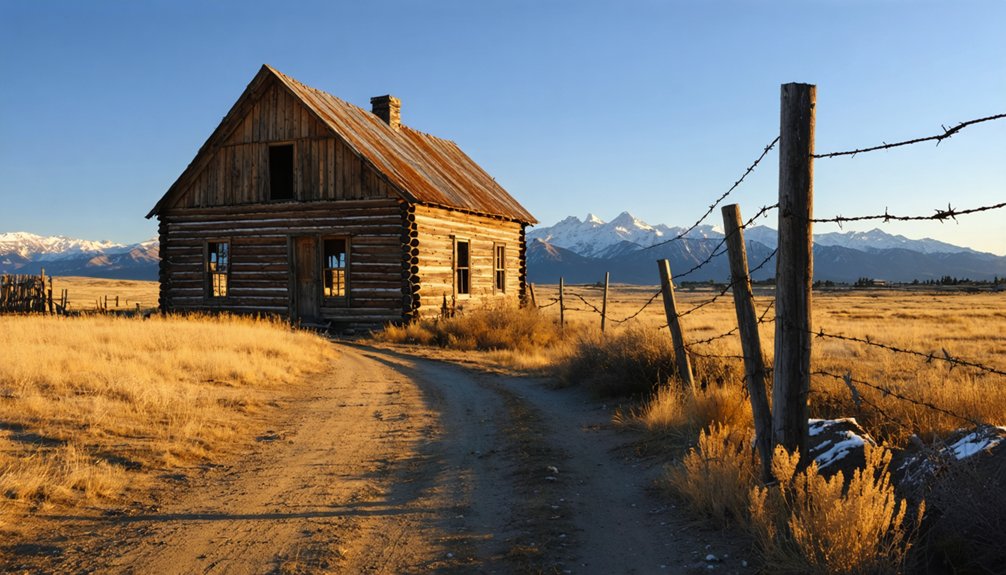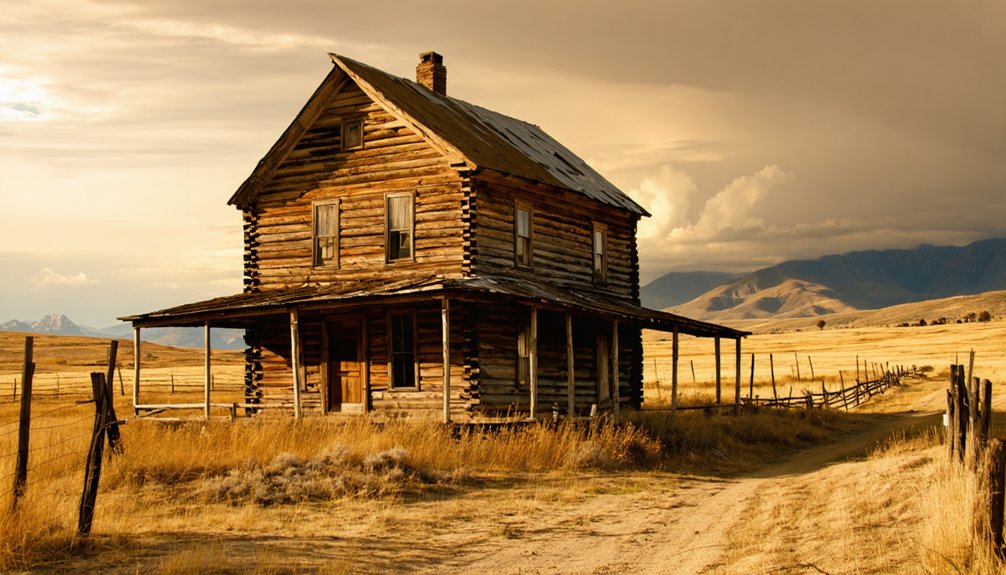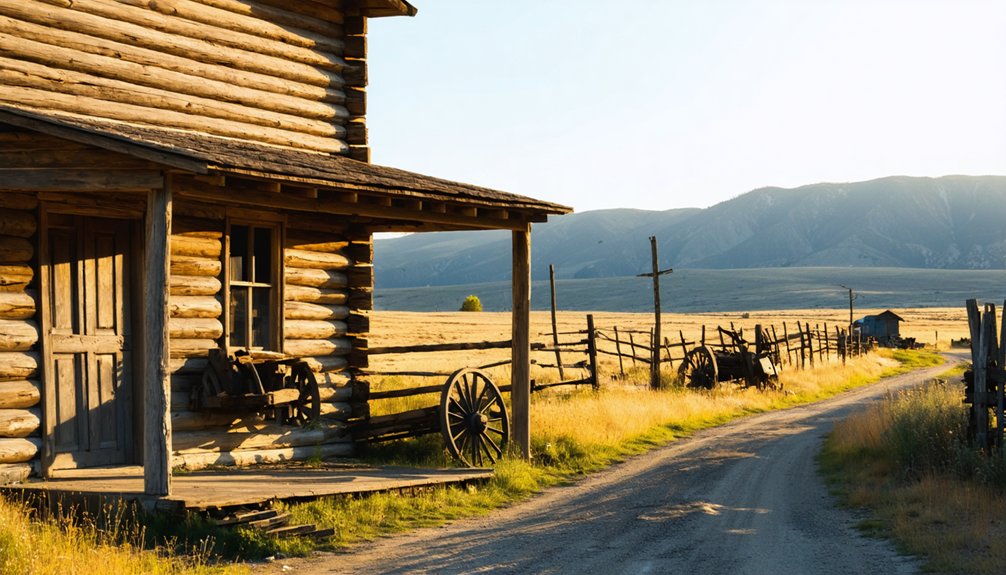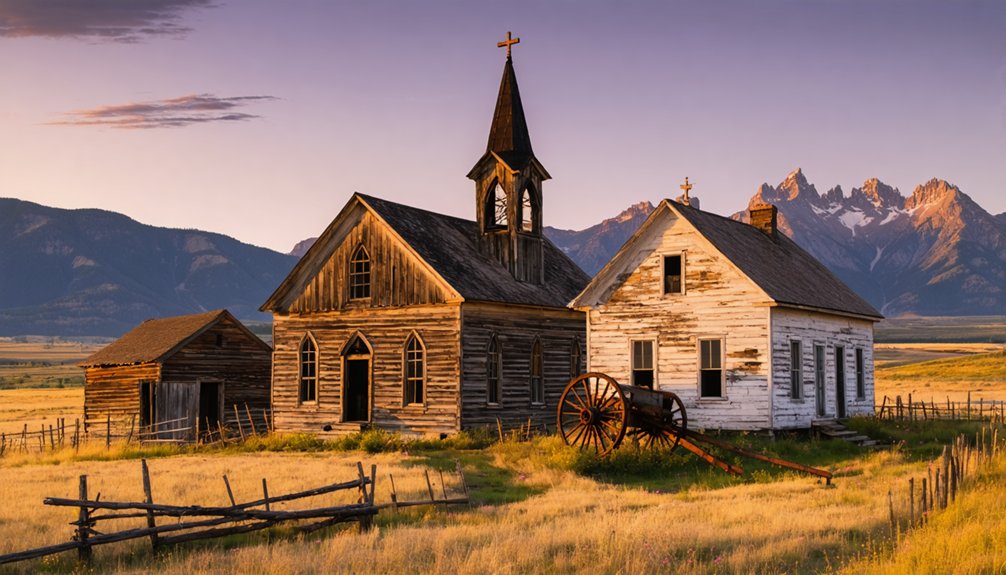You’ll discover Chesterfield’s haunting remains in southeastern Idaho, where this Mormon pioneer settlement once thrived with over 400 residents in the 1920s. Founded in 1879 by Bishop Chester Call, the town flourished until brutal winters, severe droughts, and the railroad’s bypass led to its decline. Today, the Chesterfield Foundation preserves 41 historic buildings across 2,160 acres, including the striking Greek Revival meetinghouse – each structure telling a tale of frontier perseverance and ultimate abandonment.
Key Takeaways
- Chesterfield, Idaho was established in 1879 by Mormon settlers and grew to over 400 residents before becoming a ghost town.
- The town’s decline began when the Oregon Short Line Railroad bypassed it in 1882, shifting commerce to nearby Bancroft.
- Brutal winters reaching -60°F, severe droughts, and agricultural challenges forced many families to abandon their settlements.
- The historic district spans 2,160 acres and contains 41 buildings on the National Register, including the Greek Revival LDS Meetinghouse.
- The Chesterfield Foundation now preserves the ghost town’s legacy across 120 acres, protecting historic structures and pioneer cemetery.
A Mormon Pioneer Settlement Takes Root
While many Mormon settlements spread across the American West in the late 1800s, Chesterfield’s story began in 1879 when LDS Bishop Chester Call and his nephew Christian Nelson established their homesteads in southeastern Idaho.
Despite pioneer challenges, the settlement quickly took shape after Church leaders visited in 1882, selecting an ideal townsite location that would mirror traditional Mormon community planning.
You’ll find that Chesterfield, named after its founder and bearing resemblance to its English namesake, exemplified community resilience as it grew to over 400 residents by the 1920s.
The settlers built impressive brick structures between 1884 and 1904, establishing essential community buildings like a church, school, and general store that transformed this frontier outpost into a thriving Mormon colony.
The Oregon Trail travelers regularly received aid and supplies from the generous local pioneers.
The settlement’s initial prosperity would later face decline when the railroad bypassed the town, shifting economic activity to nearby Bancroft instead.
Life in the Harsh Idaho Frontier
You’d have found life in Chesterfield’s harsh frontier testing your limits, especially during the brutal winters when temperatures plummeted well below zero and howling winds swept across the Snake River Plain.
Each day brought a constant struggle against nature as you’d need to maintain a steady supply of firewood, preserve enough food to last through winter, and keep your livestock alive in the unforgiving climate. Families relied on their underground root cellars to store up to 800 pounds of food supplies through the long winters. Following the traditions of other frontier settlements, families built compact communities to better support each other and share resources.
Even the simplest tasks, like fetching water or tending to crops, required careful planning and extraordinary effort in a landscape where the weather could turn deadly at a moment’s notice.
Surviving Brutal Winter Conditions
Life in Chesterfield tested even the hardiest frontier settlers, as brutal winters plunged temperatures to a staggering 60 degrees below zero Fahrenheit.
You’d find snow piling up to eight feet deep, burying buildings to their roofs and making roads impassable for weeks at a time.
Winter preparation became a matter of survival. You’d hear the wood in pioneer buildings creaking and snapping from the intense cold while you waited out the storms.
Despite careful planning, the harsh conditions took their toll – 1,600 sheep perished in a single season.
Community resilience proved essential as neighbors shared resources and helped stranded travelers. The Mormon settlement traditions helped foster this spirit of cooperation and mutual aid.
During these isolating months, you’d focus on indoor tasks and rely on stored provisions. Modern-day caretakers still pass the time by watching DVDs during long winter nights.
Still, many settlers eventually abandoned Chesterfield, unable to endure the relentless winter siege year after year.
Pioneer Daily Living Hardships
Beyond the bitter cold, daily survival in Chesterfield demanded constant vigilance and backbreaking labor.
You’d spend countless hours practicing subsistence farming, battling unpredictable weather and pests that threatened to destroy your crops. Pioneer families had to maintain complete self-sufficiency, making their own clothes, food, and shelter from scratch. Without modern conveniences, you’d preserve your harvest through endless hours of drying, smoking, and pickling – hoping it would last through winter.
The pioneer families often found themselves in land usage conflicts with local Native American tribes as they established their farms and homesteads.
Irrigation challenges tested your resolve daily as you dug ditches by hand to channel precious water to your fields.
You’d face constant threats from disease with no doctors nearby, forcing you to rely on home remedies and whatever medical knowledge you’d brought west. Every injury, every failed crop, and every contaminated water source could spell disaster for your family.
The harsh frontier wouldn’t forgive mistakes, demanding resilience just to make it through each day.
The Town’s Golden Era: 1880s-1920s
During its golden era spanning the 1880s through the early 1920s, Chesterfield flourished as a tribute to Mormon pioneers’ determination in Idaho’s rugged Portneuf Valley.
Mormon pioneers transformed Chesterfield into a testament of frontier perseverance during its four-decade prime in Idaho’s untamed Portneuf Valley.
You’d have found a thriving community of 73 families at its peak, with cultural traditions centered around the meetinghouse and general store. Community gatherings at the tithing office strengthened bonds among the 400-plus residents. The Holbrook Mercantile store served as both a community shopping hub and the church bishop’s office. Given the multiple locations called Chesterfield, this particular settlement required place name disambiguation to distinguish it from others.
The town’s prosperity came from diverse sources – you’d have seen cowboys tending 300-horse herds, loggers selling timber to the Oregon Short Line Railroad, and farmers working the challenging soil.
While harsh winters reaching -60°F and summer droughts tested their resolve, the townspeople maintained a supportive network, helping Oregon Trail travelers with supplies and medical care.
Their pioneering spirit created a remarkable chapter in Idaho’s frontier history.
Notable Buildings and Architecture
While Chesterfield’s historic district spans over 2,160 acres, you’ll find its architectural heart in the 41 buildings and eight sites that earned National Register status in 1980.
The LDS Meetinghouse stands as the crown jewel, blending Greek Revival and Queen Anne architectural influences in its 1887-1892 construction.
You can trace the town’s evolution through its buildings, from early dugouts and log cabins to sophisticated brick homes fired in local kilns.
The Edward Reese house showcases this progression perfectly, with its original log cabin and later lumber addition.
Community structures like the Holbrook Mercantile and Blacksmith Shop reflect the self-sufficient pioneer spirit, while preservation challenges haven’t diminished their historical authenticity.
Most buildings maintain their original locations, offering you a genuine glimpse into late 19th-century Mormon settlement architecture.
Natural Disasters and Economic Hardships

You’ll find Chesterfield’s most devastating period occurred during the brutal winters of 1898-1900 and 1908, when temperatures plummeted to 60 degrees below zero and snow piled eight feet deep, decimating livestock and causing numerous deaths.
The town’s economic stability took another hit when the Portland to St. Louis railroad bypassed Chesterfield in favor of nearby Bancroft, effectively redirecting commerce away from the struggling settlement.
These combined hardships proved insurmountable for many residents, as the harsh climate and lack of rail access gradually transformed this once-thriving community into a ghost town.
Brutal Winter Devastation 1898-1908
As nature released its fury on Chesterfield between 1898 and 1908, the pioneering settlement faced some of the harshest winters ever recorded in Idaho’s history.
You’ll find records of temperatures plummeting to -60 degrees Fahrenheit, while snow piled up to eight feet deep, testing pioneer resilience to its limits. At 5,400 feet elevation, the valley floor offered little protection from winter’s brutal assault.
The toll on winter survival was devastating. You’d have witnessed the death of 1,600 sheep, widespread illness among children, and rising death rates throughout the community.
These conditions, paired with severe drought from 1898-1900, dealt crushing blows to the settlement’s agricultural foundation. The harsh reality forced many families to abandon their dreams, contributing to Chesterfield’s eventual transformation into a ghost town.
Railroad Bypass Economic Impact
The Oregon Short Line Railroad‘s decision to bypass Chesterfield in 1882 marked the beginning of the town’s economic decline.
You can trace the railroad consequences through the emergence of Bancroft, established in 1898 just eight miles south along the tracks, which quickly siphoned away Chesterfield’s commercial importance.
The economic isolation hit local farmers hardest. Without direct rail access, they couldn’t competitively transport their crops and livestock to distant markets.
You’ll find that businesses and merchants naturally gravitated toward Bancroft’s rail-connected economy, leaving Chesterfield’s stores and services to wither.
The town’s younger generations sought opportunities elsewhere, and the remaining residents faced mounting challenges as their community’s institutions – schools, churches, and shops – gradually shut down, unable to sustain themselves in the rail-bypassed settlement.
The Railroad’s Impact on Chesterfield
When the Oregon Short Line Railroad bypassed Chesterfield in 1882, choosing instead to run through nearby Bancroft, it sealed the town’s eventual fate.
You can still see the railroad’s significance in the region’s economic transformation, as Chesterfield’s once-bustling streets gradually emptied while Bancroft flourished as the area’s commercial hub.
- You’d have witnessed fewer wagon trains passing through town as travelers opted for faster rail transportation.
- Your logging business would’ve suffered as the initial boom in selling railroad ties came to an end.
- You’d have watched your neighbors move away as economic opportunities dried up.
- Your town’s infrastructure would’ve deteriorated as commercial activity shifted to railroad-connected Bancroft.
The railroad’s path reshaped the region’s destiny, leaving Chesterfield to fade into a reflection of pioneer resilience.
From Thriving Community to Abandonment

Once a bustling pioneer settlement of 418 residents, Chesterfield’s transformation into a ghost town unfolded through a perfect storm of calamities.
You’ll find the story of pioneer resilience tested by brutal winters reaching -60°F, devastating droughts, and massive livestock losses that crippled the town’s economic foundation.
Between 1898 and 1908, community dynamics shifted dramatically as the population halved, with families forced to abandon their dreams of agricultural prosperity.
When the railroad bypassed Chesterfield for nearby Bancroft in 1898, you would’ve witnessed the town’s isolation deepen.
The strong social bonds that once defined this Mormon pioneer community gradually unraveled as more families sought opportunities elsewhere.
The Chesterfield Foundation’s Preservation Efforts
Despite decades of abandonment, Chesterfield’s historic legacy endures through dedicated preservation efforts spearheaded by the Chesterfield Foundation.
The Chesterfield Foundation breathes new life into this historic treasure, refusing to let time erase the stories of our past.
You’ll find authentic restoration techniques being applied across the 120-acre site, where volunteers work tirelessly to preserve dozens of 19th-century structures. The Foundation’s commitment to community engagement has created a powerful alliance of local workers, youth groups, and descendants of original settlers.
- Skilled craftsmen employ period-specific methods to repair log cabins and restore brick buildings
- Summer volunteer programs draw hundreds of dedicated workers who maintain historic integrity
- Major grants, including a $125,000 award, fuel preservation while keeping costs manageable
- The Foundation protects 2,160 acres of historic district, including the cemetery where pioneers rest
Walking Through History: A Pioneer Legacy

As you explore the historic grounds of Chesterfield today, you’ll walk in the footsteps of resilient Mormon pioneers who carved out a remarkable settlement in southeast Idaho’s Portneuf Valley in 1880.
Unlike typical Mormon colonies, Chesterfield’s pioneer culture emerged organically when Chester Call and Christian Nelson established their horse ranch, drawing other settlers to this challenging frontier.
You’ll find evidence of community resilience in the 27 surviving structures across 100 acres, including the hand-fired brick meetinghouse.
These buildings tell stories of settlers who endured brutal winters below -60°F, devastating droughts, and locust swarms.
The cemetery’s weathered headstones reveal the harsh realities of frontier life, while also serving as a testament to a determined people who maintained their traditions of hospitality, helping Oregon Trail travelers with food and fresh horses.
Frequently Asked Questions
Are There Any Reported Ghost Sightings or Paranormal Activities in Chesterfield?
You won’t find documented ghost stories or paranormal investigations here. While the town’s pioneer history and harsh winters could fuel supernatural tales, no credible sightings or haunting reports exist.
Can Visitors Stay Overnight in Any of the Restored Buildings?
You can’t stay overnight in Chesterfield’s restored buildings, as they’re maintained strictly for historical tours. While building accessibility is limited to daytime visits, you’ll find camping and nearby modern overnight accommodations available.
What Artifacts From Original Settlers Have Been Found During Restoration?
You’ll discover rusted cans, broken crockery, blue glass fragments, settler tools, and farm implements alongside historical documents like tithing records detailing contributions of butter, eggs, hay, and livestock.
Does Chesterfield Hold Any Special Events Besides the Memorial Day Celebration?
You’ll find the site’s busiest time is Memorial Day, but you won’t find regular local festivals or historical reenactments throughout the season beyond occasional blacksmith demos and pioneer activities.
Are There Hiking Trails or Camping Areas Near the Ghost Town?
You’ll find pristine hiking routes winding through nearby National Forests, including historic Oregon Trail paths. The Chesterfield Foundation maintains camping facilities on-site, while surrounding wilderness offers primitive camping opportunities.
References
- https://www.idahomagazine.com/article/chesterfield-spotlight/
- https://www.youtube.com/watch?v=IqV57c1eY28
- https://idahohighcountry.org/item/chesterfield-historic-town-site/
- https://abandonedidaho.com/2024/12/21/chesterfield-ghost-town/
- https://www.historicchesterfield.org/about.html
- https://www.tripadvisor.com/Attraction_Review-g35384-d1127717-Reviews-Chesterfield_Townsite-Bancroft_Idaho.html
- https://visitidaho.org/things-to-do/ghost-towns-mining-history/chesterfield-historic-town-site/
- https://www.historicchesterfield.org
- https://history.idaho.gov/wp-content/uploads/2018/09/Chesterfield_Historic_District_80001297.pdf
- https://ensignpeakfoundation.org/chesterfield-historic-town-site/



